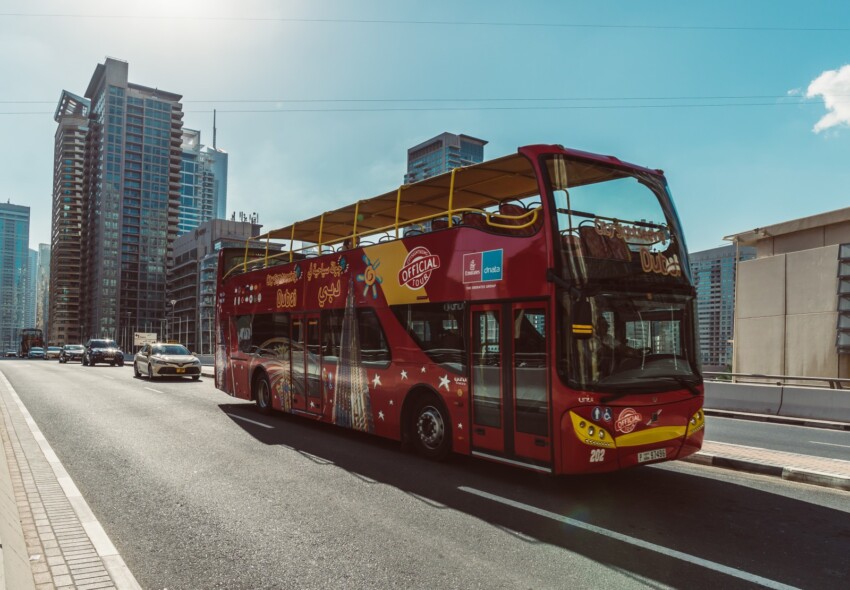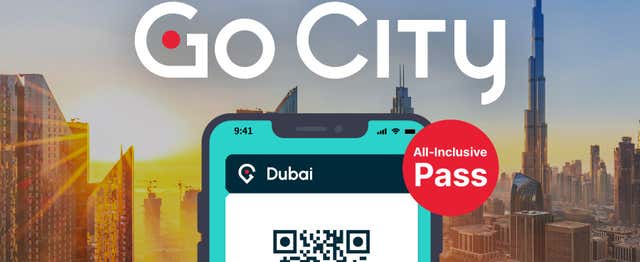
A bus tour is a great way to see Dubai, especially when time is at a premium. Sightseeing tours are conducted on board characteristic double-decker buses: the upper deck is open-top while the lower deck is air-conditioned, needless to say that on scorching summer days the upper deck is practically deserted.
Audio guides are available in many languages and the route passes through the city’s main tourist sites. Usually the bus tours in Dubai are of the‘hop on hop off‘ type, i.e. you can get on and off at will at each stop with a single ticket, which usually lasts the whole day. Of course, it is also possible to never get off and take advantage of the audio guide for a quick and extensive tour of Dubai.
However, being a huge and rather unusual city, bus tours in Dubai follow different routes and different itineraries. They are even run by two competing companies, Big Bus Tours and City Sightseeing, which fight bitterly to provide the best service at the best value for money.
While Big Bus Tours’ three tours could be many, the City Sightseeing company offers as many as six, named Historic Route (red), Modern Route (blue), Cruise Terminal Route (green), Marina Route (yellow), Global Village & Miracle Garden Route (orange) and Palm Crescent Route (purple).
The red, blue, yellow and violet tours are practically a perfect match for those of Big Bus Tours, while the novelties introduced by this bus tour company in Dubai are the green route, designed especially for cruise passengers arriving in the city and to take them to the Dubai Mall (from there it is possible to continue the visit to the city with another of the bus tours or independently), and the orange route, which goes inland from Dubai until reaching Global Village.
It is still a rather uncrowded route, not in the least because it is only seasonal, but it is perfect in the context of Dubai’s expansion: it is already possible to stop and visit the Miracle Garden, the racetrack and the Global Village attractions.
City Sightseeing, like Big Bus Tours, also offers combinations of 24-hour and 48-hour tickets, and something free to whet tourists’ appetites. The company gives away a cruise on the Dhow, admission to several museums, a night tour of Dubai, a ticket to the Abra, some walking tours around Bastakiya and the Dubai Mall, and even a complimentary coffee at one of the city’s best-known chains.
Those who purchase the 48-hour ticket are also entitled to a free entry to the Dubai Aquarium and Underwater Zoo, located inside the Dubai Mall, and the panoramic city tour of Sharjah.
A new feature introduced by City Sightseeing is the possibility to enjoy an audio guide specially designed for children. The three characters featured in the commentary are Alice, Ali and Ghantoot: Alice is in Dubai for the first time, while Ali is a fan of City Sightseeing bus tours. Ghantoot is a very wise guide, and together the three of them will introduce the little tourists to the magical stories Dubai has to offer.
Big Bus Tours is a company that operates in 17 cities around the world (in Europe it is present in Budapest, Istanbul, London, Paris and Vienna). Its buses are dark red in colour and its offer includes three routes, called City Tour (red colour), Beach Tour (green colour) and Marina Tour (blue colour).
For all three tours, you only need to buy one ticket, which can be valid for 24 or 48 hours. It is also possible to buy a super combined tour to discover Dubai and Abu Dhabi with a free round-trip shuttle between the two cities, and in each case included in the price are free entries to 10 museums, a desert sunset excursion, a panoramic tour of Sharjah and entry to the Atlantis Aquarium.
The City Tour (red) allows you to see historic Dubai. It starts from the Wafi stop, located a short distance from Creek Park, passing behind Sheikh Zayed Road to arrive in Downtown Dubai to visit the Dubai Mall and the Burj Khalifa, and returns to the Bur Dubai area thus allowing access to the historical part of the city: it is possible to visit the Grand Mosque, the souks of Bur Dubai, until crossing the Creek at the Al Shindagha tunnel and thus finding oneself in Deira.
Here the tour allows you to visit the gold souk and the spice souk, passing along the Creek to admire the scenes of daily life on the dhows’ wharves, to end the tour at the Deira City Centre shopping centre and thus return to the Wafi departure stop.
The Beach Tour (green) is the itinerary that perhaps makes one appreciate the architectural wonders of modern Dubai at their best. It starts from the Dubai Mall, skirts Downtown Dubai to allow one to admire the Burj Khalifa from different angles and crosses Sheikh Zayed Road to arrive at the Jumeirah Mosque.
From here onwards, the stops are all made along the beaches of Jumeirah, until reaching the Burj Al Arab and proceeding along Palm Jumeirah, the artificial palm-shaped island, which is travelled all the way to the iconic Atlantis Hotel. The backward route runs lengthwise through the Jumeirah district to the Mall of the Emirates, before picking up Sheikh Zayed Road and returning to the Dubai Mall.
The Marina Tour (blue) is the last of the three Big Bus Tours itineraries, and starts right where the green itinerary ends, i.e. at the Mall of the Emirates. The bus then heads south, circling the beautiful Dubai Marina district, stopping no less than 11 times at different locations.
Before returning to the Mall of the Emirates the Marina Tour goes up the trunk of Palm Jumeirah, stops at the Atlantis like the Green Tour but unlike the latter it goes along the entire breakwater to allow one to admire some interesting views of one of the most incredible artificial islands in the world.
Buses in Dubai are very modern and efficient, as is the case with all public transport in the city. The bus network is very extensive, especially in the northern part of the city between Deira and Bur Dubai: the two main bus stops are Gold Souq Bus Station (Deira side) and Al Ghubaiba Bus Station (Bur Dubai side), both of which are used by about 20 lines each.
However, the public bus system is not sufficient to cater for the volume of people using it every day. This means that in the hottest parts of the city, especially during peak hours, commuters have to wait for over an hour before they can board a bus.
Unfortunately, the number of buses in Dubai does not grow at the same rate as the number of passengers, which makes the problem worse and worse as time goes on; this is why the metro is used by more and more users.
Dubai’s buses are equipped with the latest technologies such as a voice announcement of the next stop in Arabic and English, a passenger counting system used by drivers to check the current load of the vehicle, and a GPS positioning system used by the network operator to keep track of the location of buses in the city in real time.
In addition to the normal lines, which run throughout the city, there are two particular categories of bus lines in Dubai: the first is identified by the letter N before the number, and characterises the night buses, which run throughout the night although they have a rather limited frequency.
The second category are the so-called feeder buses, which connect the city’s neighbourhoods with the metro lines (called this way to give the idea of feeding, or replenishing, the metro lines with passengers) and are distinguished by the letter F before the number.
Dubai’s bus stops are unique in the world and are a popular and much-photographed attraction for tourists: they are covered and fully air-conditioned, shaped like something out of a science fiction film, and inside are benches, a map of the surrounding area and the full timetable of all the lines that stop at the stop.
Inside the stops there are numerous prohibitions, sanctioned with fines of various amounts: you are not allowed to lie down on the benches, you may not daub them with drawings or graffiti, you may not eat or drink. But they are a great find especially in summer, when waiting for the bus outdoors in 50 degrees could be a traumatic experience.
City Card allow you to save on public transport and / or on the entrances to the main tourist attractions.
